BTEC HND Unit 4: Management and Operations Report - Tesco
VerifiedAdded on 2023/01/13
|14
|3837
|65
Report
AI Summary
This report provides a comprehensive analysis of leadership and management principles within Tesco, a leading British retailer. The report begins by differentiating between the roles and characteristics of managers and leaders, exploring their respective functions and skills. It then delves into various leadership approaches, including situational, system, and contingency leadership, evaluating their strengths and weaknesses through practical examples. The report further examines different approaches to operation management such as Total Quality Management, Just in Time, and Kaizen, highlighting their significance in achieving business objectives. It also details the role and functions of a store manager in operations management and analyzes the key factors influencing business operations, such as efficiency enhancement. Finally, the report critically evaluates the application of operation management strategies within Tesco, providing a holistic view of leadership and operational effectiveness in a real-world business context.
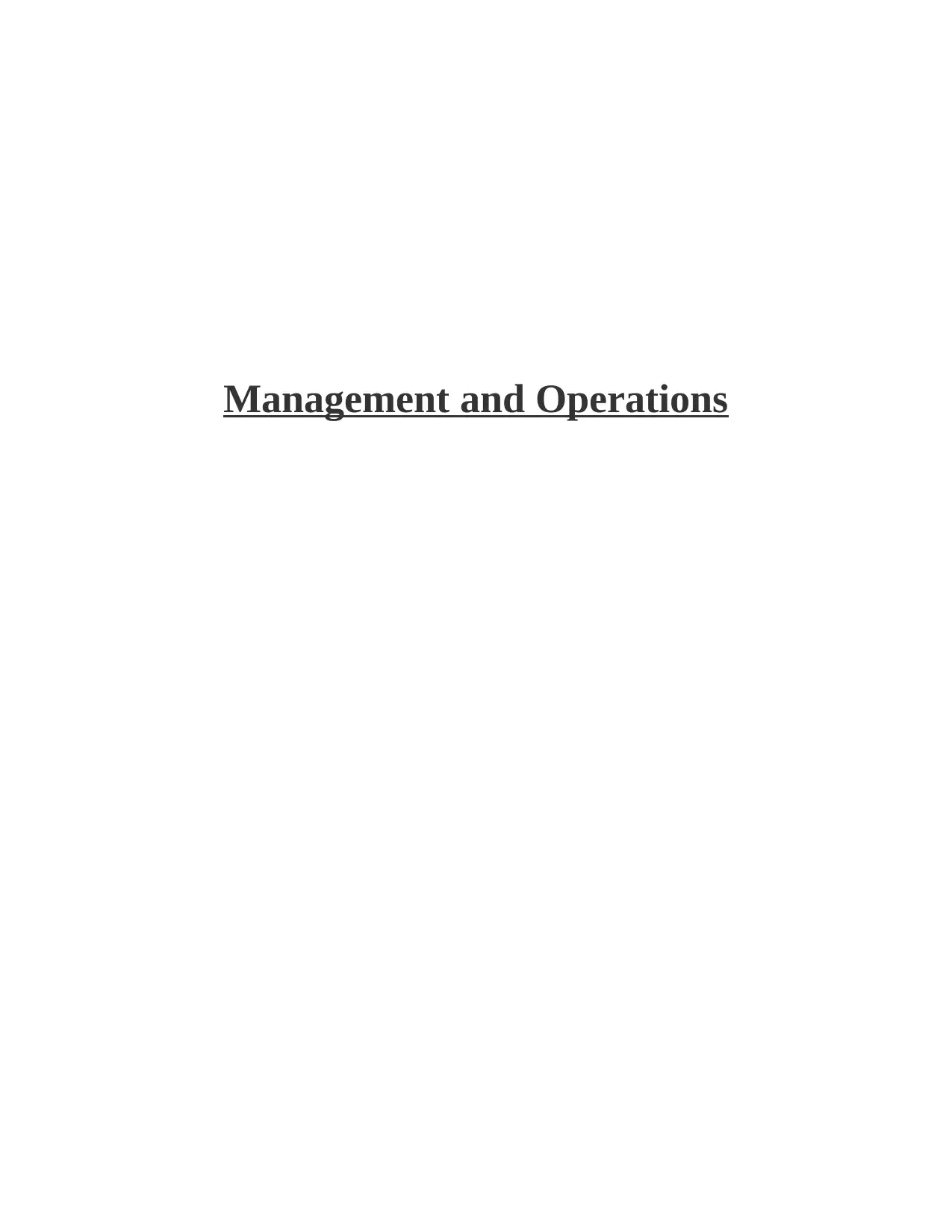
Management and Operations
Paraphrase This Document
Need a fresh take? Get an instant paraphrase of this document with our AI Paraphraser
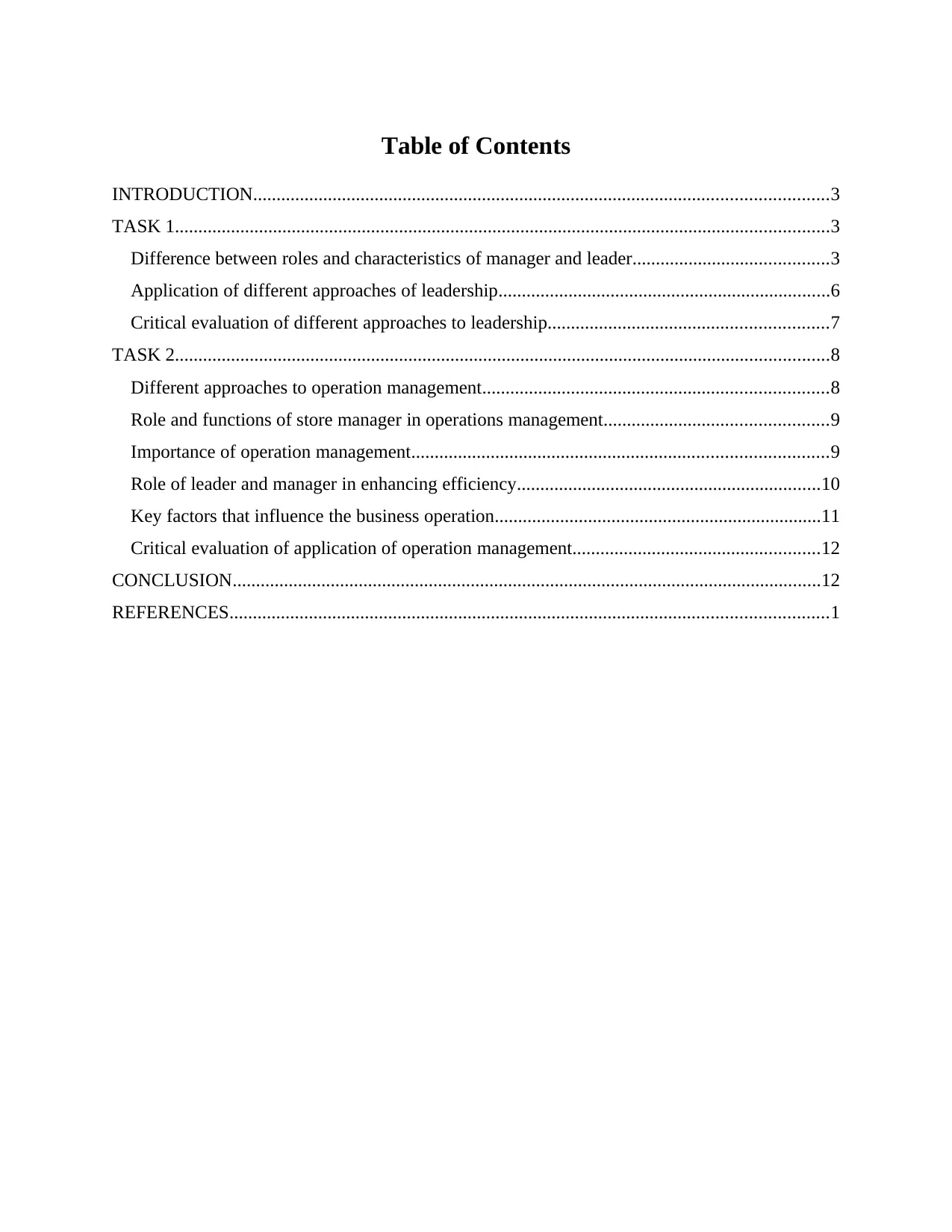
Table of Contents
INTRODUCTION...........................................................................................................................3
TASK 1............................................................................................................................................3
Difference between roles and characteristics of manager and leader..........................................3
Application of different approaches of leadership.......................................................................6
Critical evaluation of different approaches to leadership............................................................7
TASK 2............................................................................................................................................8
Different approaches to operation management..........................................................................8
Role and functions of store manager in operations management................................................9
Importance of operation management.........................................................................................9
Role of leader and manager in enhancing efficiency.................................................................10
Key factors that influence the business operation......................................................................11
Critical evaluation of application of operation management.....................................................12
CONCLUSION..............................................................................................................................12
REFERENCES................................................................................................................................1
INTRODUCTION...........................................................................................................................3
TASK 1............................................................................................................................................3
Difference between roles and characteristics of manager and leader..........................................3
Application of different approaches of leadership.......................................................................6
Critical evaluation of different approaches to leadership............................................................7
TASK 2............................................................................................................................................8
Different approaches to operation management..........................................................................8
Role and functions of store manager in operations management................................................9
Importance of operation management.........................................................................................9
Role of leader and manager in enhancing efficiency.................................................................10
Key factors that influence the business operation......................................................................11
Critical evaluation of application of operation management.....................................................12
CONCLUSION..............................................................................................................................12
REFERENCES................................................................................................................................1
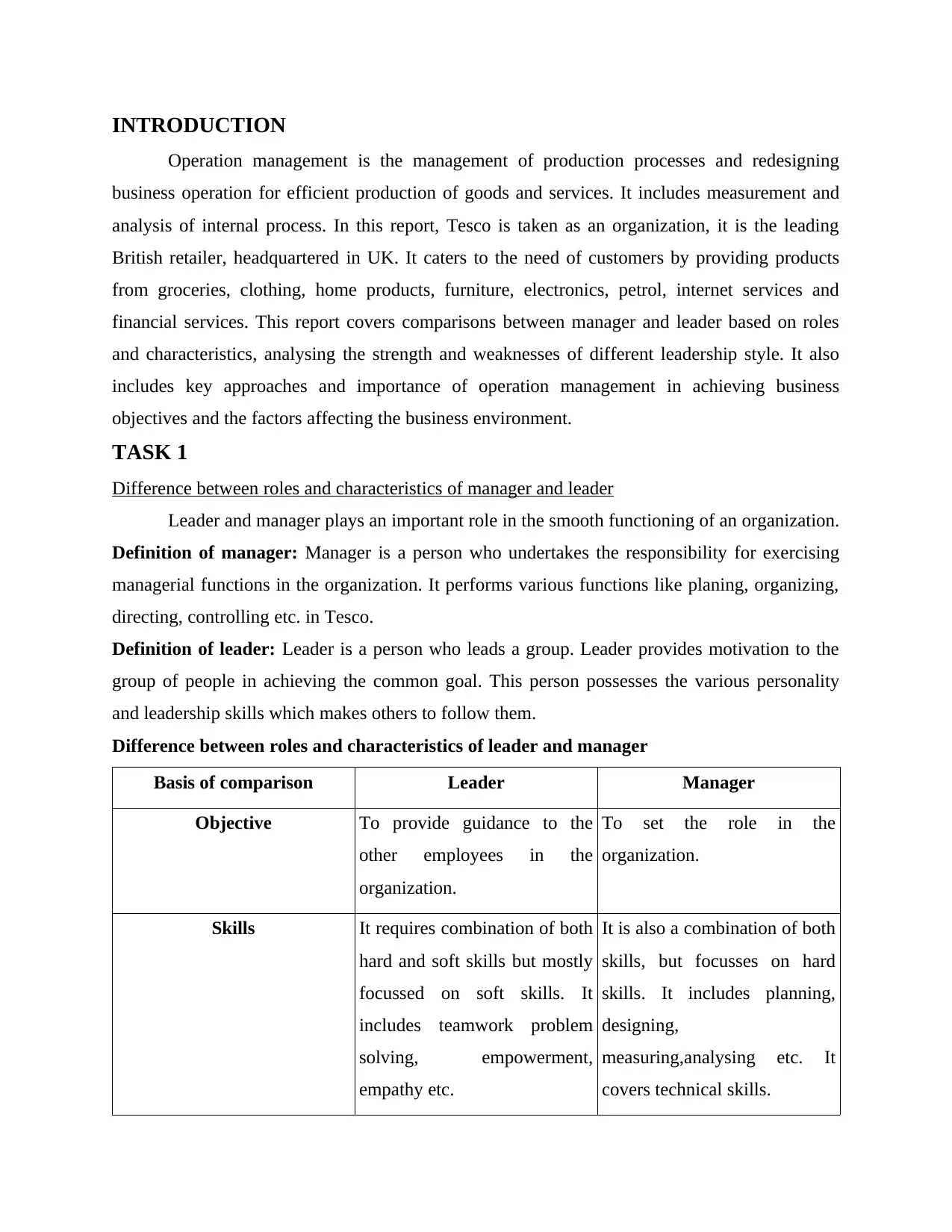
INTRODUCTION
Operation management is the management of production processes and redesigning
business operation for efficient production of goods and services. It includes measurement and
analysis of internal process. In this report, Tesco is taken as an organization, it is the leading
British retailer, headquartered in UK. It caters to the need of customers by providing products
from groceries, clothing, home products, furniture, electronics, petrol, internet services and
financial services. This report covers comparisons between manager and leader based on roles
and characteristics, analysing the strength and weaknesses of different leadership style. It also
includes key approaches and importance of operation management in achieving business
objectives and the factors affecting the business environment.
TASK 1
Difference between roles and characteristics of manager and leader
Leader and manager plays an important role in the smooth functioning of an organization.
Definition of manager: Manager is a person who undertakes the responsibility for exercising
managerial functions in the organization. It performs various functions like planing, organizing,
directing, controlling etc. in Tesco.
Definition of leader: Leader is a person who leads a group. Leader provides motivation to the
group of people in achieving the common goal. This person possesses the various personality
and leadership skills which makes others to follow them.
Difference between roles and characteristics of leader and manager
Basis of comparison Leader Manager
Objective To provide guidance to the
other employees in the
organization.
To set the role in the
organization.
Skills It requires combination of both
hard and soft skills but mostly
focussed on soft skills. It
includes teamwork problem
solving, empowerment,
empathy etc.
It is also a combination of both
skills, but focusses on hard
skills. It includes planning,
designing,
measuring,analysing etc. It
covers technical skills.
Operation management is the management of production processes and redesigning
business operation for efficient production of goods and services. It includes measurement and
analysis of internal process. In this report, Tesco is taken as an organization, it is the leading
British retailer, headquartered in UK. It caters to the need of customers by providing products
from groceries, clothing, home products, furniture, electronics, petrol, internet services and
financial services. This report covers comparisons between manager and leader based on roles
and characteristics, analysing the strength and weaknesses of different leadership style. It also
includes key approaches and importance of operation management in achieving business
objectives and the factors affecting the business environment.
TASK 1
Difference between roles and characteristics of manager and leader
Leader and manager plays an important role in the smooth functioning of an organization.
Definition of manager: Manager is a person who undertakes the responsibility for exercising
managerial functions in the organization. It performs various functions like planing, organizing,
directing, controlling etc. in Tesco.
Definition of leader: Leader is a person who leads a group. Leader provides motivation to the
group of people in achieving the common goal. This person possesses the various personality
and leadership skills which makes others to follow them.
Difference between roles and characteristics of leader and manager
Basis of comparison Leader Manager
Objective To provide guidance to the
other employees in the
organization.
To set the role in the
organization.
Skills It requires combination of both
hard and soft skills but mostly
focussed on soft skills. It
includes teamwork problem
solving, empowerment,
empathy etc.
It is also a combination of both
skills, but focusses on hard
skills. It includes planning,
designing,
measuring,analysing etc. It
covers technical skills.
⊘ This is a preview!⊘
Do you want full access?
Subscribe today to unlock all pages.

Trusted by 1+ million students worldwide
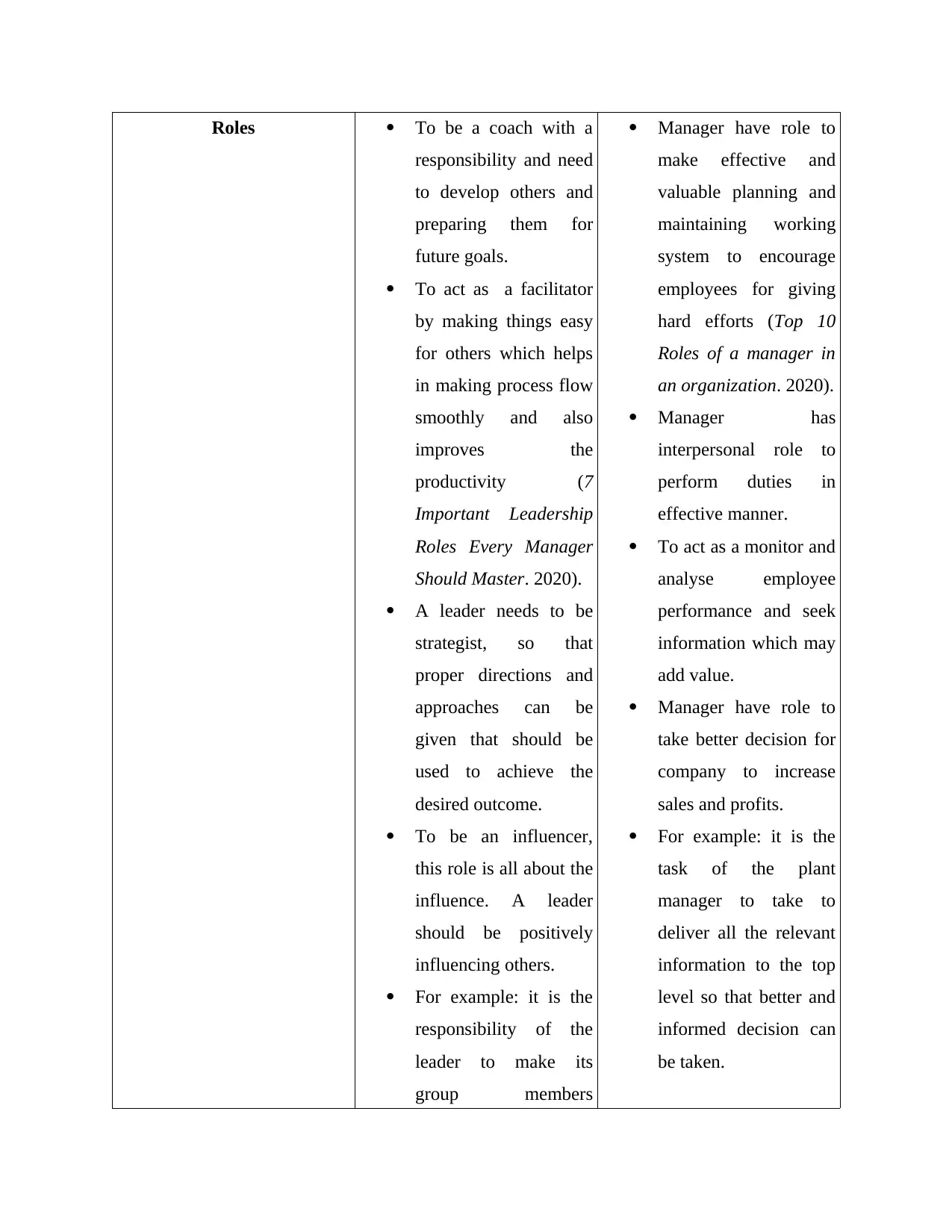
Roles To be a coach with a
responsibility and need
to develop others and
preparing them for
future goals.
To act as a facilitator
by making things easy
for others which helps
in making process flow
smoothly and also
improves the
productivity (7
Important Leadership
Roles Every Manager
Should Master. 2020).
A leader needs to be
strategist, so that
proper directions and
approaches can be
given that should be
used to achieve the
desired outcome.
To be an influencer,
this role is all about the
influence. A leader
should be positively
influencing others.
For example: it is the
responsibility of the
leader to make its
group members
Manager have role to
make effective and
valuable planning and
maintaining working
system to encourage
employees for giving
hard efforts (Top 10
Roles of a manager in
an organization. 2020).
Manager has
interpersonal role to
perform duties in
effective manner.
To act as a monitor and
analyse employee
performance and seek
information which may
add value.
Manager have role to
take better decision for
company to increase
sales and profits.
For example: it is the
task of the plant
manager to take to
deliver all the relevant
information to the top
level so that better and
informed decision can
be taken.
responsibility and need
to develop others and
preparing them for
future goals.
To act as a facilitator
by making things easy
for others which helps
in making process flow
smoothly and also
improves the
productivity (7
Important Leadership
Roles Every Manager
Should Master. 2020).
A leader needs to be
strategist, so that
proper directions and
approaches can be
given that should be
used to achieve the
desired outcome.
To be an influencer,
this role is all about the
influence. A leader
should be positively
influencing others.
For example: it is the
responsibility of the
leader to make its
group members
Manager have role to
make effective and
valuable planning and
maintaining working
system to encourage
employees for giving
hard efforts (Top 10
Roles of a manager in
an organization. 2020).
Manager has
interpersonal role to
perform duties in
effective manner.
To act as a monitor and
analyse employee
performance and seek
information which may
add value.
Manager have role to
take better decision for
company to increase
sales and profits.
For example: it is the
task of the plant
manager to take to
deliver all the relevant
information to the top
level so that better and
informed decision can
be taken.
Paraphrase This Document
Need a fresh take? Get an instant paraphrase of this document with our AI Paraphraser
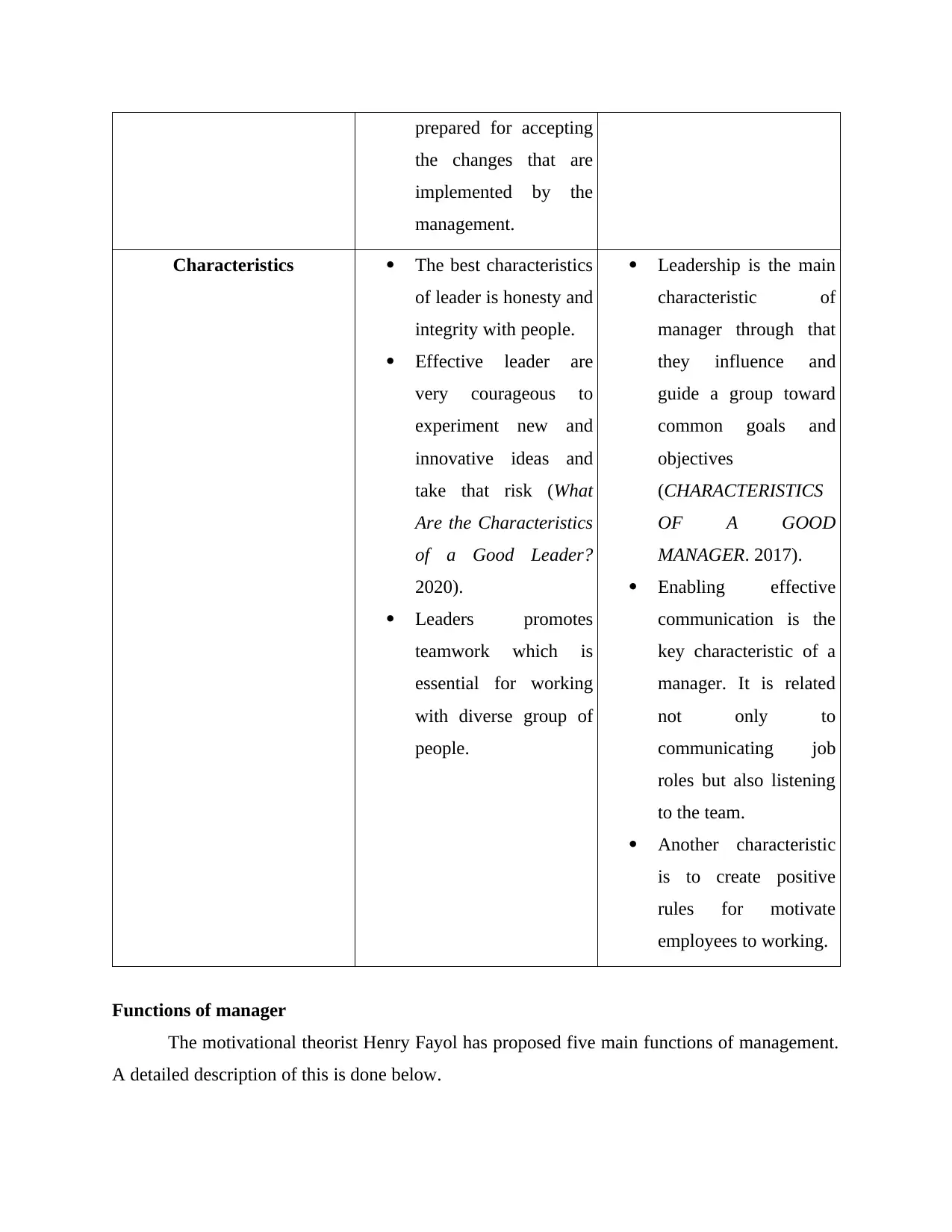
prepared for accepting
the changes that are
implemented by the
management.
Characteristics The best characteristics
of leader is honesty and
integrity with people.
Effective leader are
very courageous to
experiment new and
innovative ideas and
take that risk (What
Are the Characteristics
of a Good Leader?
2020).
Leaders promotes
teamwork which is
essential for working
with diverse group of
people.
Leadership is the main
characteristic of
manager through that
they influence and
guide a group toward
common goals and
objectives
(CHARACTERISTICS
OF A GOOD
MANAGER. 2017).
Enabling effective
communication is the
key characteristic of a
manager. It is related
not only to
communicating job
roles but also listening
to the team.
Another characteristic
is to create positive
rules for motivate
employees to working.
Functions of manager
The motivational theorist Henry Fayol has proposed five main functions of management.
A detailed description of this is done below.
the changes that are
implemented by the
management.
Characteristics The best characteristics
of leader is honesty and
integrity with people.
Effective leader are
very courageous to
experiment new and
innovative ideas and
take that risk (What
Are the Characteristics
of a Good Leader?
2020).
Leaders promotes
teamwork which is
essential for working
with diverse group of
people.
Leadership is the main
characteristic of
manager through that
they influence and
guide a group toward
common goals and
objectives
(CHARACTERISTICS
OF A GOOD
MANAGER. 2017).
Enabling effective
communication is the
key characteristic of a
manager. It is related
not only to
communicating job
roles but also listening
to the team.
Another characteristic
is to create positive
rules for motivate
employees to working.
Functions of manager
The motivational theorist Henry Fayol has proposed five main functions of management.
A detailed description of this is done below.
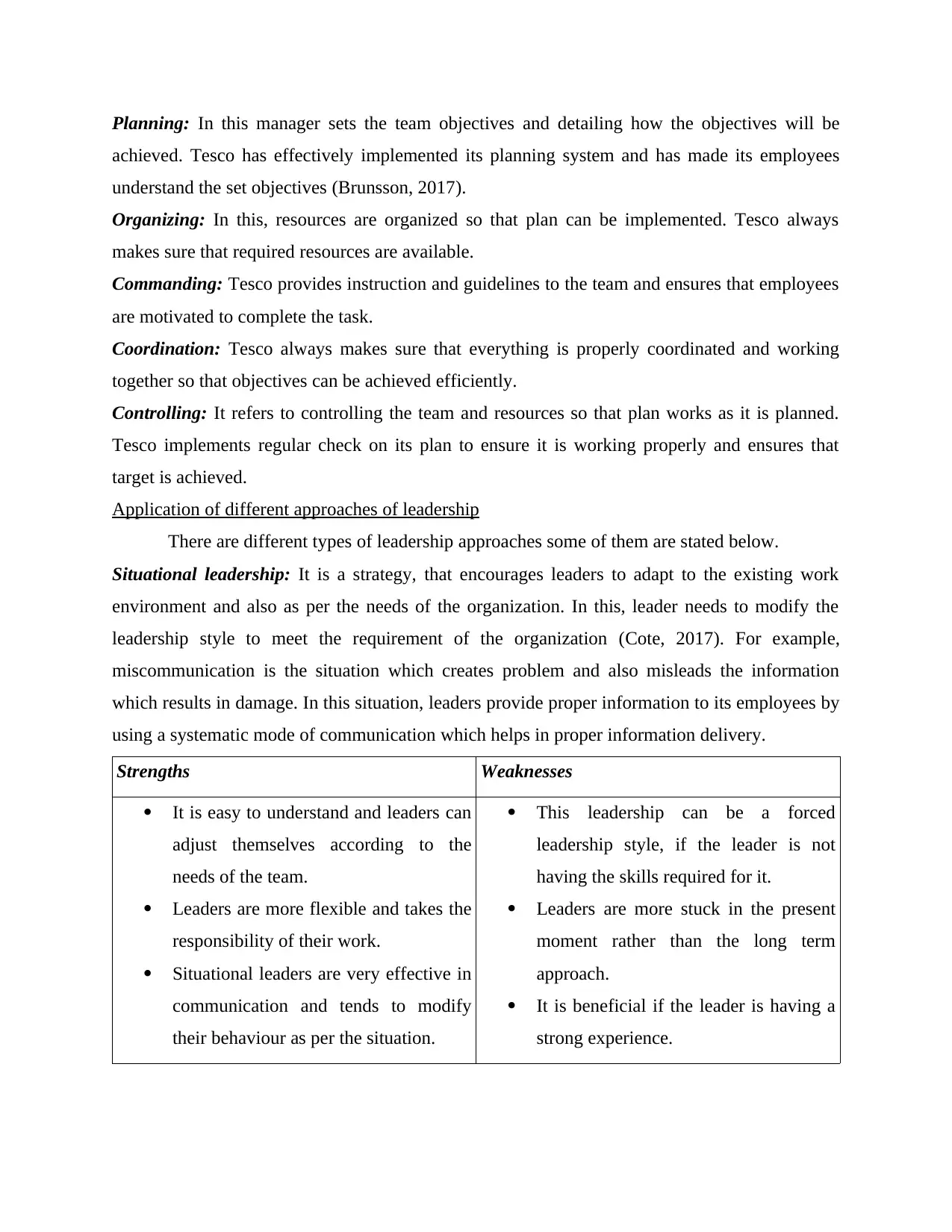
Planning: In this manager sets the team objectives and detailing how the objectives will be
achieved. Tesco has effectively implemented its planning system and has made its employees
understand the set objectives (Brunsson, 2017).
Organizing: In this, resources are organized so that plan can be implemented. Tesco always
makes sure that required resources are available.
Commanding: Tesco provides instruction and guidelines to the team and ensures that employees
are motivated to complete the task.
Coordination: Tesco always makes sure that everything is properly coordinated and working
together so that objectives can be achieved efficiently.
Controlling: It refers to controlling the team and resources so that plan works as it is planned.
Tesco implements regular check on its plan to ensure it is working properly and ensures that
target is achieved.
Application of different approaches of leadership
There are different types of leadership approaches some of them are stated below.
Situational leadership: It is a strategy, that encourages leaders to adapt to the existing work
environment and also as per the needs of the organization. In this, leader needs to modify the
leadership style to meet the requirement of the organization (Cote, 2017). For example,
miscommunication is the situation which creates problem and also misleads the information
which results in damage. In this situation, leaders provide proper information to its employees by
using a systematic mode of communication which helps in proper information delivery.
Strengths Weaknesses
It is easy to understand and leaders can
adjust themselves according to the
needs of the team.
Leaders are more flexible and takes the
responsibility of their work.
Situational leaders are very effective in
communication and tends to modify
their behaviour as per the situation.
This leadership can be a forced
leadership style, if the leader is not
having the skills required for it.
Leaders are more stuck in the present
moment rather than the long term
approach.
It is beneficial if the leader is having a
strong experience.
achieved. Tesco has effectively implemented its planning system and has made its employees
understand the set objectives (Brunsson, 2017).
Organizing: In this, resources are organized so that plan can be implemented. Tesco always
makes sure that required resources are available.
Commanding: Tesco provides instruction and guidelines to the team and ensures that employees
are motivated to complete the task.
Coordination: Tesco always makes sure that everything is properly coordinated and working
together so that objectives can be achieved efficiently.
Controlling: It refers to controlling the team and resources so that plan works as it is planned.
Tesco implements regular check on its plan to ensure it is working properly and ensures that
target is achieved.
Application of different approaches of leadership
There are different types of leadership approaches some of them are stated below.
Situational leadership: It is a strategy, that encourages leaders to adapt to the existing work
environment and also as per the needs of the organization. In this, leader needs to modify the
leadership style to meet the requirement of the organization (Cote, 2017). For example,
miscommunication is the situation which creates problem and also misleads the information
which results in damage. In this situation, leaders provide proper information to its employees by
using a systematic mode of communication which helps in proper information delivery.
Strengths Weaknesses
It is easy to understand and leaders can
adjust themselves according to the
needs of the team.
Leaders are more flexible and takes the
responsibility of their work.
Situational leaders are very effective in
communication and tends to modify
their behaviour as per the situation.
This leadership can be a forced
leadership style, if the leader is not
having the skills required for it.
Leaders are more stuck in the present
moment rather than the long term
approach.
It is beneficial if the leader is having a
strong experience.
⊘ This is a preview!⊘
Do you want full access?
Subscribe today to unlock all pages.

Trusted by 1+ million students worldwide
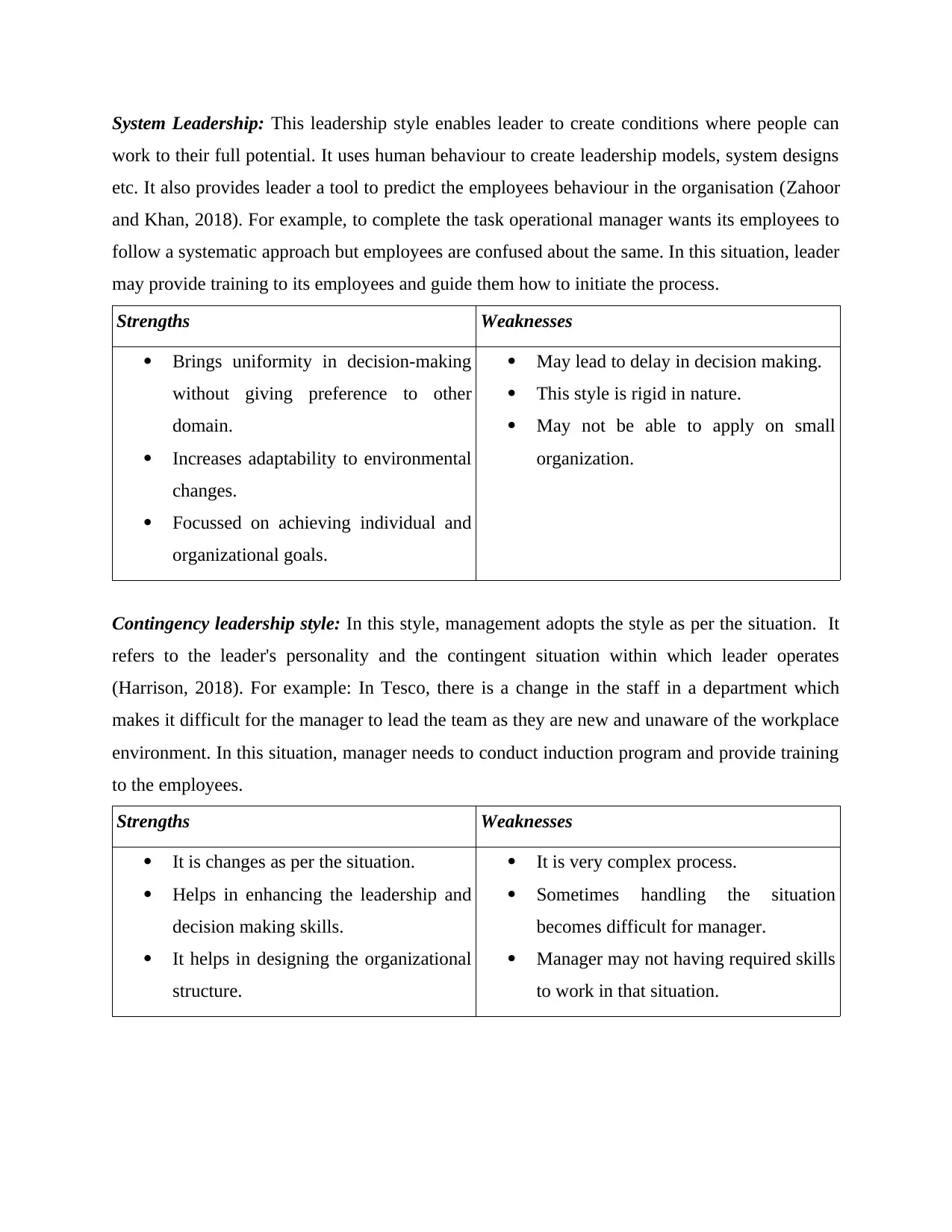
System Leadership: This leadership style enables leader to create conditions where people can
work to their full potential. It uses human behaviour to create leadership models, system designs
etc. It also provides leader a tool to predict the employees behaviour in the organisation (Zahoor
and Khan, 2018). For example, to complete the task operational manager wants its employees to
follow a systematic approach but employees are confused about the same. In this situation, leader
may provide training to its employees and guide them how to initiate the process.
Strengths Weaknesses
Brings uniformity in decision-making
without giving preference to other
domain.
Increases adaptability to environmental
changes.
Focussed on achieving individual and
organizational goals.
May lead to delay in decision making.
This style is rigid in nature.
May not be able to apply on small
organization.
Contingency leadership style: In this style, management adopts the style as per the situation. It
refers to the leader's personality and the contingent situation within which leader operates
(Harrison, 2018). For example: In Tesco, there is a change in the staff in a department which
makes it difficult for the manager to lead the team as they are new and unaware of the workplace
environment. In this situation, manager needs to conduct induction program and provide training
to the employees.
Strengths Weaknesses
It is changes as per the situation.
Helps in enhancing the leadership and
decision making skills.
It helps in designing the organizational
structure.
It is very complex process.
Sometimes handling the situation
becomes difficult for manager.
Manager may not having required skills
to work in that situation.
work to their full potential. It uses human behaviour to create leadership models, system designs
etc. It also provides leader a tool to predict the employees behaviour in the organisation (Zahoor
and Khan, 2018). For example, to complete the task operational manager wants its employees to
follow a systematic approach but employees are confused about the same. In this situation, leader
may provide training to its employees and guide them how to initiate the process.
Strengths Weaknesses
Brings uniformity in decision-making
without giving preference to other
domain.
Increases adaptability to environmental
changes.
Focussed on achieving individual and
organizational goals.
May lead to delay in decision making.
This style is rigid in nature.
May not be able to apply on small
organization.
Contingency leadership style: In this style, management adopts the style as per the situation. It
refers to the leader's personality and the contingent situation within which leader operates
(Harrison, 2018). For example: In Tesco, there is a change in the staff in a department which
makes it difficult for the manager to lead the team as they are new and unaware of the workplace
environment. In this situation, manager needs to conduct induction program and provide training
to the employees.
Strengths Weaknesses
It is changes as per the situation.
Helps in enhancing the leadership and
decision making skills.
It helps in designing the organizational
structure.
It is very complex process.
Sometimes handling the situation
becomes difficult for manager.
Manager may not having required skills
to work in that situation.
Paraphrase This Document
Need a fresh take? Get an instant paraphrase of this document with our AI Paraphraser
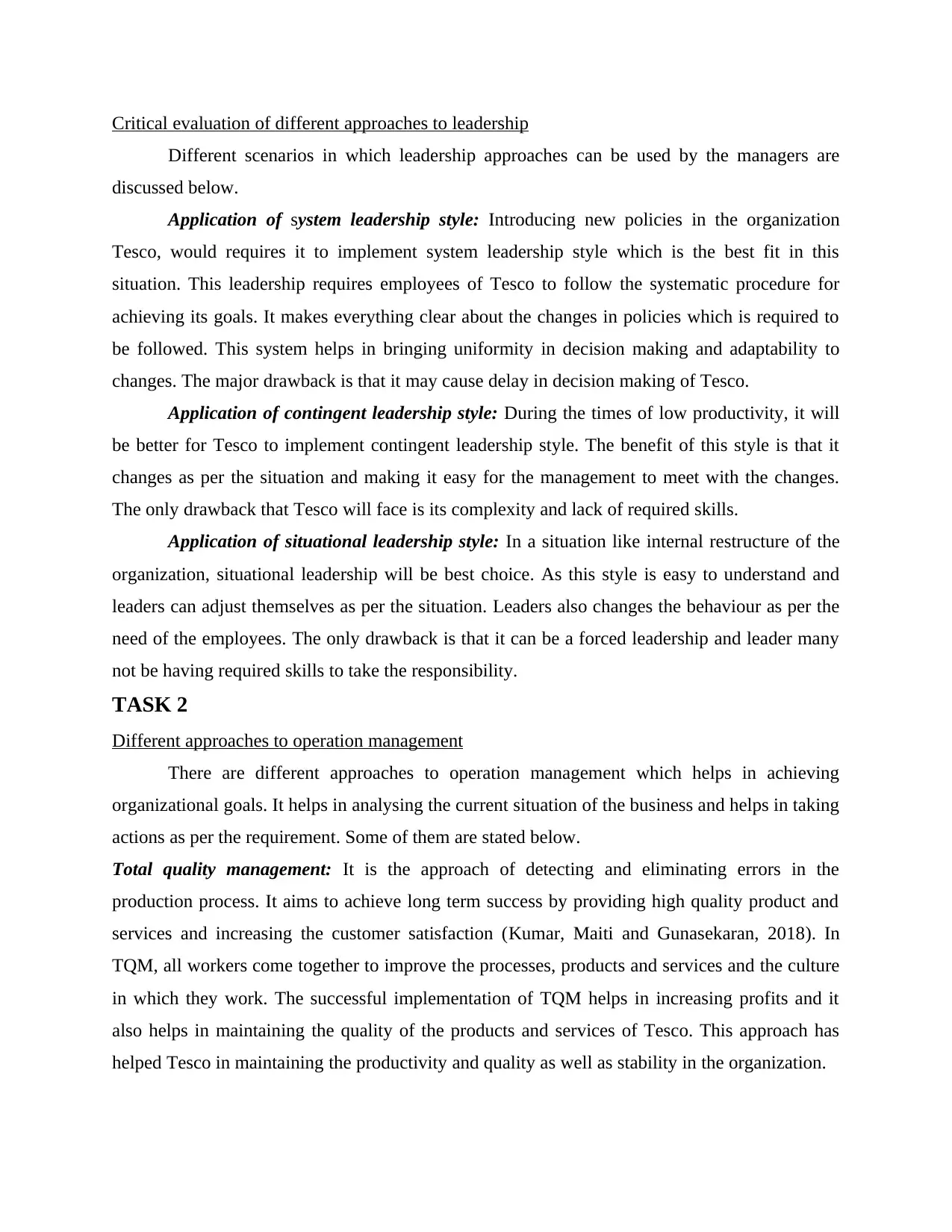
Critical evaluation of different approaches to leadership
Different scenarios in which leadership approaches can be used by the managers are
discussed below.
Application of system leadership style: Introducing new policies in the organization
Tesco, would requires it to implement system leadership style which is the best fit in this
situation. This leadership requires employees of Tesco to follow the systematic procedure for
achieving its goals. It makes everything clear about the changes in policies which is required to
be followed. This system helps in bringing uniformity in decision making and adaptability to
changes. The major drawback is that it may cause delay in decision making of Tesco.
Application of contingent leadership style: During the times of low productivity, it will
be better for Tesco to implement contingent leadership style. The benefit of this style is that it
changes as per the situation and making it easy for the management to meet with the changes.
The only drawback that Tesco will face is its complexity and lack of required skills.
Application of situational leadership style: In a situation like internal restructure of the
organization, situational leadership will be best choice. As this style is easy to understand and
leaders can adjust themselves as per the situation. Leaders also changes the behaviour as per the
need of the employees. The only drawback is that it can be a forced leadership and leader many
not be having required skills to take the responsibility.
TASK 2
Different approaches to operation management
There are different approaches to operation management which helps in achieving
organizational goals. It helps in analysing the current situation of the business and helps in taking
actions as per the requirement. Some of them are stated below.
Total quality management: It is the approach of detecting and eliminating errors in the
production process. It aims to achieve long term success by providing high quality product and
services and increasing the customer satisfaction (Kumar, Maiti and Gunasekaran, 2018). In
TQM, all workers come together to improve the processes, products and services and the culture
in which they work. The successful implementation of TQM helps in increasing profits and it
also helps in maintaining the quality of the products and services of Tesco. This approach has
helped Tesco in maintaining the productivity and quality as well as stability in the organization.
Different scenarios in which leadership approaches can be used by the managers are
discussed below.
Application of system leadership style: Introducing new policies in the organization
Tesco, would requires it to implement system leadership style which is the best fit in this
situation. This leadership requires employees of Tesco to follow the systematic procedure for
achieving its goals. It makes everything clear about the changes in policies which is required to
be followed. This system helps in bringing uniformity in decision making and adaptability to
changes. The major drawback is that it may cause delay in decision making of Tesco.
Application of contingent leadership style: During the times of low productivity, it will
be better for Tesco to implement contingent leadership style. The benefit of this style is that it
changes as per the situation and making it easy for the management to meet with the changes.
The only drawback that Tesco will face is its complexity and lack of required skills.
Application of situational leadership style: In a situation like internal restructure of the
organization, situational leadership will be best choice. As this style is easy to understand and
leaders can adjust themselves as per the situation. Leaders also changes the behaviour as per the
need of the employees. The only drawback is that it can be a forced leadership and leader many
not be having required skills to take the responsibility.
TASK 2
Different approaches to operation management
There are different approaches to operation management which helps in achieving
organizational goals. It helps in analysing the current situation of the business and helps in taking
actions as per the requirement. Some of them are stated below.
Total quality management: It is the approach of detecting and eliminating errors in the
production process. It aims to achieve long term success by providing high quality product and
services and increasing the customer satisfaction (Kumar, Maiti and Gunasekaran, 2018). In
TQM, all workers come together to improve the processes, products and services and the culture
in which they work. The successful implementation of TQM helps in increasing profits and it
also helps in maintaining the quality of the products and services of Tesco. This approach has
helped Tesco in maintaining the productivity and quality as well as stability in the organization.
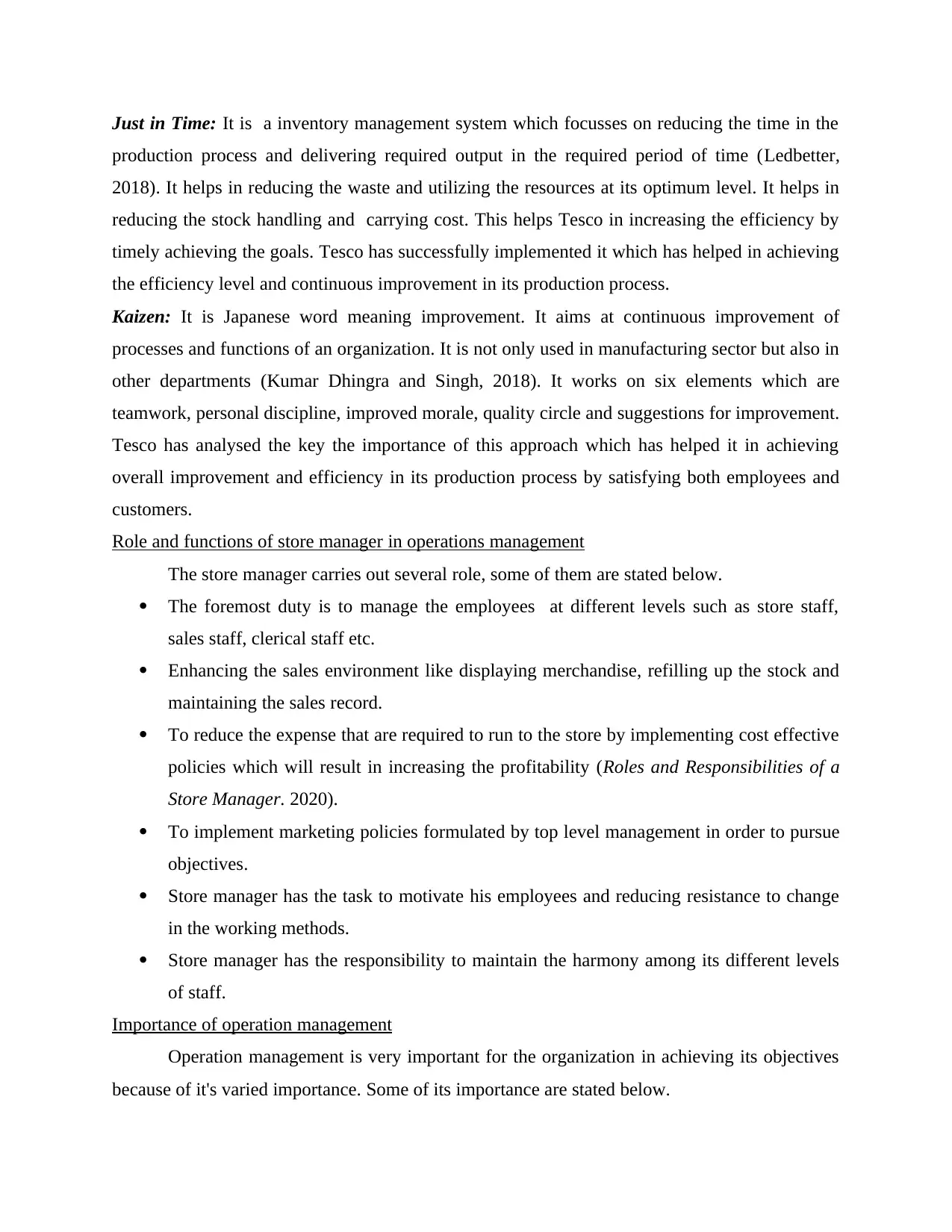
Just in Time: It is a inventory management system which focusses on reducing the time in the
production process and delivering required output in the required period of time (Ledbetter,
2018). It helps in reducing the waste and utilizing the resources at its optimum level. It helps in
reducing the stock handling and carrying cost. This helps Tesco in increasing the efficiency by
timely achieving the goals. Tesco has successfully implemented it which has helped in achieving
the efficiency level and continuous improvement in its production process.
Kaizen: It is Japanese word meaning improvement. It aims at continuous improvement of
processes and functions of an organization. It is not only used in manufacturing sector but also in
other departments (Kumar Dhingra and Singh, 2018). It works on six elements which are
teamwork, personal discipline, improved morale, quality circle and suggestions for improvement.
Tesco has analysed the key the importance of this approach which has helped it in achieving
overall improvement and efficiency in its production process by satisfying both employees and
customers.
Role and functions of store manager in operations management
The store manager carries out several role, some of them are stated below.
The foremost duty is to manage the employees at different levels such as store staff,
sales staff, clerical staff etc.
Enhancing the sales environment like displaying merchandise, refilling up the stock and
maintaining the sales record.
To reduce the expense that are required to run to the store by implementing cost effective
policies which will result in increasing the profitability (Roles and Responsibilities of a
Store Manager. 2020).
To implement marketing policies formulated by top level management in order to pursue
objectives.
Store manager has the task to motivate his employees and reducing resistance to change
in the working methods.
Store manager has the responsibility to maintain the harmony among its different levels
of staff.
Importance of operation management
Operation management is very important for the organization in achieving its objectives
because of it's varied importance. Some of its importance are stated below.
production process and delivering required output in the required period of time (Ledbetter,
2018). It helps in reducing the waste and utilizing the resources at its optimum level. It helps in
reducing the stock handling and carrying cost. This helps Tesco in increasing the efficiency by
timely achieving the goals. Tesco has successfully implemented it which has helped in achieving
the efficiency level and continuous improvement in its production process.
Kaizen: It is Japanese word meaning improvement. It aims at continuous improvement of
processes and functions of an organization. It is not only used in manufacturing sector but also in
other departments (Kumar Dhingra and Singh, 2018). It works on six elements which are
teamwork, personal discipline, improved morale, quality circle and suggestions for improvement.
Tesco has analysed the key the importance of this approach which has helped it in achieving
overall improvement and efficiency in its production process by satisfying both employees and
customers.
Role and functions of store manager in operations management
The store manager carries out several role, some of them are stated below.
The foremost duty is to manage the employees at different levels such as store staff,
sales staff, clerical staff etc.
Enhancing the sales environment like displaying merchandise, refilling up the stock and
maintaining the sales record.
To reduce the expense that are required to run to the store by implementing cost effective
policies which will result in increasing the profitability (Roles and Responsibilities of a
Store Manager. 2020).
To implement marketing policies formulated by top level management in order to pursue
objectives.
Store manager has the task to motivate his employees and reducing resistance to change
in the working methods.
Store manager has the responsibility to maintain the harmony among its different levels
of staff.
Importance of operation management
Operation management is very important for the organization in achieving its objectives
because of it's varied importance. Some of its importance are stated below.
⊘ This is a preview!⊘
Do you want full access?
Subscribe today to unlock all pages.

Trusted by 1+ million students worldwide
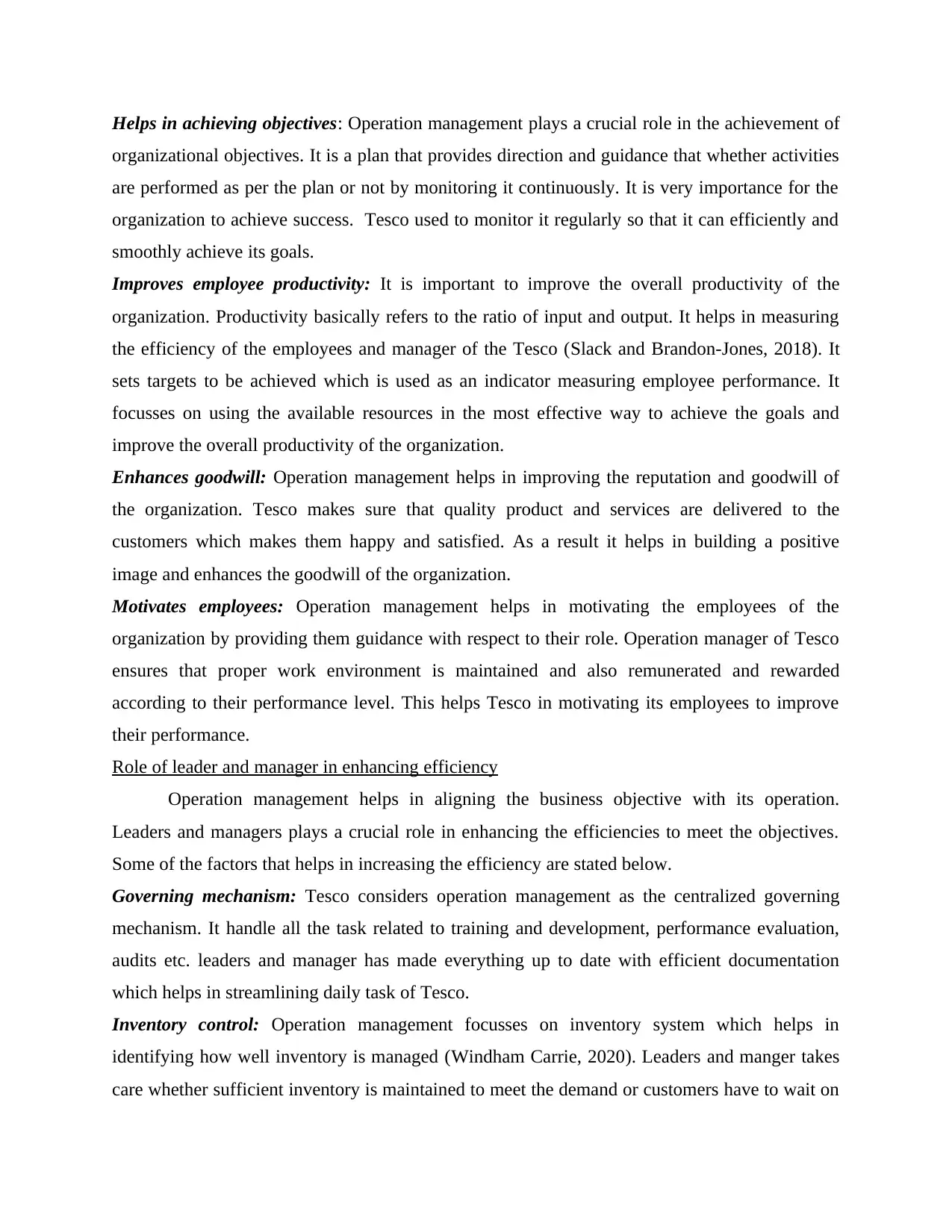
Helps in achieving objectives: Operation management plays a crucial role in the achievement of
organizational objectives. It is a plan that provides direction and guidance that whether activities
are performed as per the plan or not by monitoring it continuously. It is very importance for the
organization to achieve success. Tesco used to monitor it regularly so that it can efficiently and
smoothly achieve its goals.
Improves employee productivity: It is important to improve the overall productivity of the
organization. Productivity basically refers to the ratio of input and output. It helps in measuring
the efficiency of the employees and manager of the Tesco (Slack and Brandon-Jones, 2018). It
sets targets to be achieved which is used as an indicator measuring employee performance. It
focusses on using the available resources in the most effective way to achieve the goals and
improve the overall productivity of the organization.
Enhances goodwill: Operation management helps in improving the reputation and goodwill of
the organization. Tesco makes sure that quality product and services are delivered to the
customers which makes them happy and satisfied. As a result it helps in building a positive
image and enhances the goodwill of the organization.
Motivates employees: Operation management helps in motivating the employees of the
organization by providing them guidance with respect to their role. Operation manager of Tesco
ensures that proper work environment is maintained and also remunerated and rewarded
according to their performance level. This helps Tesco in motivating its employees to improve
their performance.
Role of leader and manager in enhancing efficiency
Operation management helps in aligning the business objective with its operation.
Leaders and managers plays a crucial role in enhancing the efficiencies to meet the objectives.
Some of the factors that helps in increasing the efficiency are stated below.
Governing mechanism: Tesco considers operation management as the centralized governing
mechanism. It handle all the task related to training and development, performance evaluation,
audits etc. leaders and manager has made everything up to date with efficient documentation
which helps in streamlining daily task of Tesco.
Inventory control: Operation management focusses on inventory system which helps in
identifying how well inventory is managed (Windham Carrie, 2020). Leaders and manger takes
care whether sufficient inventory is maintained to meet the demand or customers have to wait on
organizational objectives. It is a plan that provides direction and guidance that whether activities
are performed as per the plan or not by monitoring it continuously. It is very importance for the
organization to achieve success. Tesco used to monitor it regularly so that it can efficiently and
smoothly achieve its goals.
Improves employee productivity: It is important to improve the overall productivity of the
organization. Productivity basically refers to the ratio of input and output. It helps in measuring
the efficiency of the employees and manager of the Tesco (Slack and Brandon-Jones, 2018). It
sets targets to be achieved which is used as an indicator measuring employee performance. It
focusses on using the available resources in the most effective way to achieve the goals and
improve the overall productivity of the organization.
Enhances goodwill: Operation management helps in improving the reputation and goodwill of
the organization. Tesco makes sure that quality product and services are delivered to the
customers which makes them happy and satisfied. As a result it helps in building a positive
image and enhances the goodwill of the organization.
Motivates employees: Operation management helps in motivating the employees of the
organization by providing them guidance with respect to their role. Operation manager of Tesco
ensures that proper work environment is maintained and also remunerated and rewarded
according to their performance level. This helps Tesco in motivating its employees to improve
their performance.
Role of leader and manager in enhancing efficiency
Operation management helps in aligning the business objective with its operation.
Leaders and managers plays a crucial role in enhancing the efficiencies to meet the objectives.
Some of the factors that helps in increasing the efficiency are stated below.
Governing mechanism: Tesco considers operation management as the centralized governing
mechanism. It handle all the task related to training and development, performance evaluation,
audits etc. leaders and manager has made everything up to date with efficient documentation
which helps in streamlining daily task of Tesco.
Inventory control: Operation management focusses on inventory system which helps in
identifying how well inventory is managed (Windham Carrie, 2020). Leaders and manger takes
care whether sufficient inventory is maintained to meet the demand or customers have to wait on
Paraphrase This Document
Need a fresh take? Get an instant paraphrase of this document with our AI Paraphraser
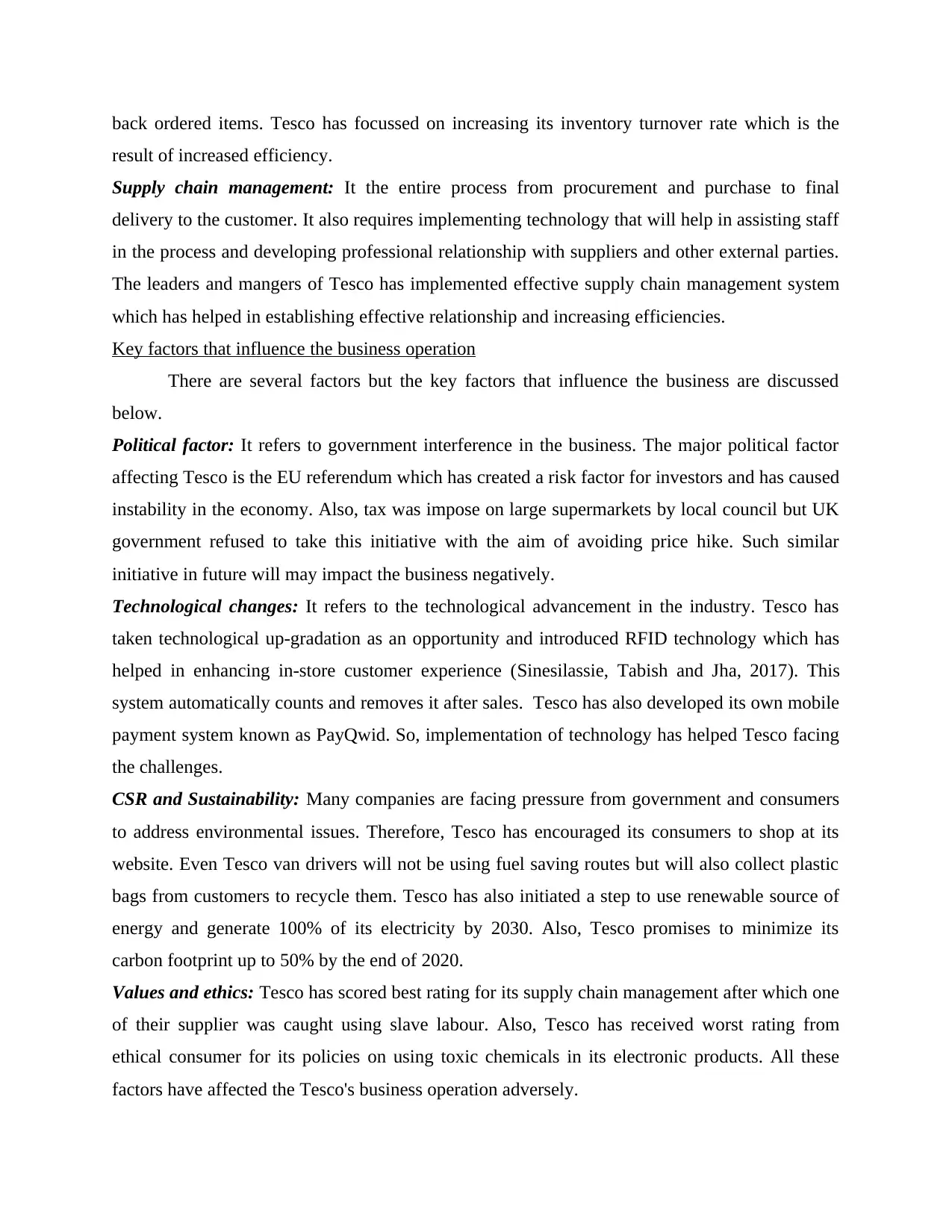
back ordered items. Tesco has focussed on increasing its inventory turnover rate which is the
result of increased efficiency.
Supply chain management: It the entire process from procurement and purchase to final
delivery to the customer. It also requires implementing technology that will help in assisting staff
in the process and developing professional relationship with suppliers and other external parties.
The leaders and mangers of Tesco has implemented effective supply chain management system
which has helped in establishing effective relationship and increasing efficiencies.
Key factors that influence the business operation
There are several factors but the key factors that influence the business are discussed
below.
Political factor: It refers to government interference in the business. The major political factor
affecting Tesco is the EU referendum which has created a risk factor for investors and has caused
instability in the economy. Also, tax was impose on large supermarkets by local council but UK
government refused to take this initiative with the aim of avoiding price hike. Such similar
initiative in future will may impact the business negatively.
Technological changes: It refers to the technological advancement in the industry. Tesco has
taken technological up-gradation as an opportunity and introduced RFID technology which has
helped in enhancing in-store customer experience (Sinesilassie, Tabish and Jha, 2017). This
system automatically counts and removes it after sales. Tesco has also developed its own mobile
payment system known as PayQwid. So, implementation of technology has helped Tesco facing
the challenges.
CSR and Sustainability: Many companies are facing pressure from government and consumers
to address environmental issues. Therefore, Tesco has encouraged its consumers to shop at its
website. Even Tesco van drivers will not be using fuel saving routes but will also collect plastic
bags from customers to recycle them. Tesco has also initiated a step to use renewable source of
energy and generate 100% of its electricity by 2030. Also, Tesco promises to minimize its
carbon footprint up to 50% by the end of 2020.
Values and ethics: Tesco has scored best rating for its supply chain management after which one
of their supplier was caught using slave labour. Also, Tesco has received worst rating from
ethical consumer for its policies on using toxic chemicals in its electronic products. All these
factors have affected the Tesco's business operation adversely.
result of increased efficiency.
Supply chain management: It the entire process from procurement and purchase to final
delivery to the customer. It also requires implementing technology that will help in assisting staff
in the process and developing professional relationship with suppliers and other external parties.
The leaders and mangers of Tesco has implemented effective supply chain management system
which has helped in establishing effective relationship and increasing efficiencies.
Key factors that influence the business operation
There are several factors but the key factors that influence the business are discussed
below.
Political factor: It refers to government interference in the business. The major political factor
affecting Tesco is the EU referendum which has created a risk factor for investors and has caused
instability in the economy. Also, tax was impose on large supermarkets by local council but UK
government refused to take this initiative with the aim of avoiding price hike. Such similar
initiative in future will may impact the business negatively.
Technological changes: It refers to the technological advancement in the industry. Tesco has
taken technological up-gradation as an opportunity and introduced RFID technology which has
helped in enhancing in-store customer experience (Sinesilassie, Tabish and Jha, 2017). This
system automatically counts and removes it after sales. Tesco has also developed its own mobile
payment system known as PayQwid. So, implementation of technology has helped Tesco facing
the challenges.
CSR and Sustainability: Many companies are facing pressure from government and consumers
to address environmental issues. Therefore, Tesco has encouraged its consumers to shop at its
website. Even Tesco van drivers will not be using fuel saving routes but will also collect plastic
bags from customers to recycle them. Tesco has also initiated a step to use renewable source of
energy and generate 100% of its electricity by 2030. Also, Tesco promises to minimize its
carbon footprint up to 50% by the end of 2020.
Values and ethics: Tesco has scored best rating for its supply chain management after which one
of their supplier was caught using slave labour. Also, Tesco has received worst rating from
ethical consumer for its policies on using toxic chemicals in its electronic products. All these
factors have affected the Tesco's business operation adversely.
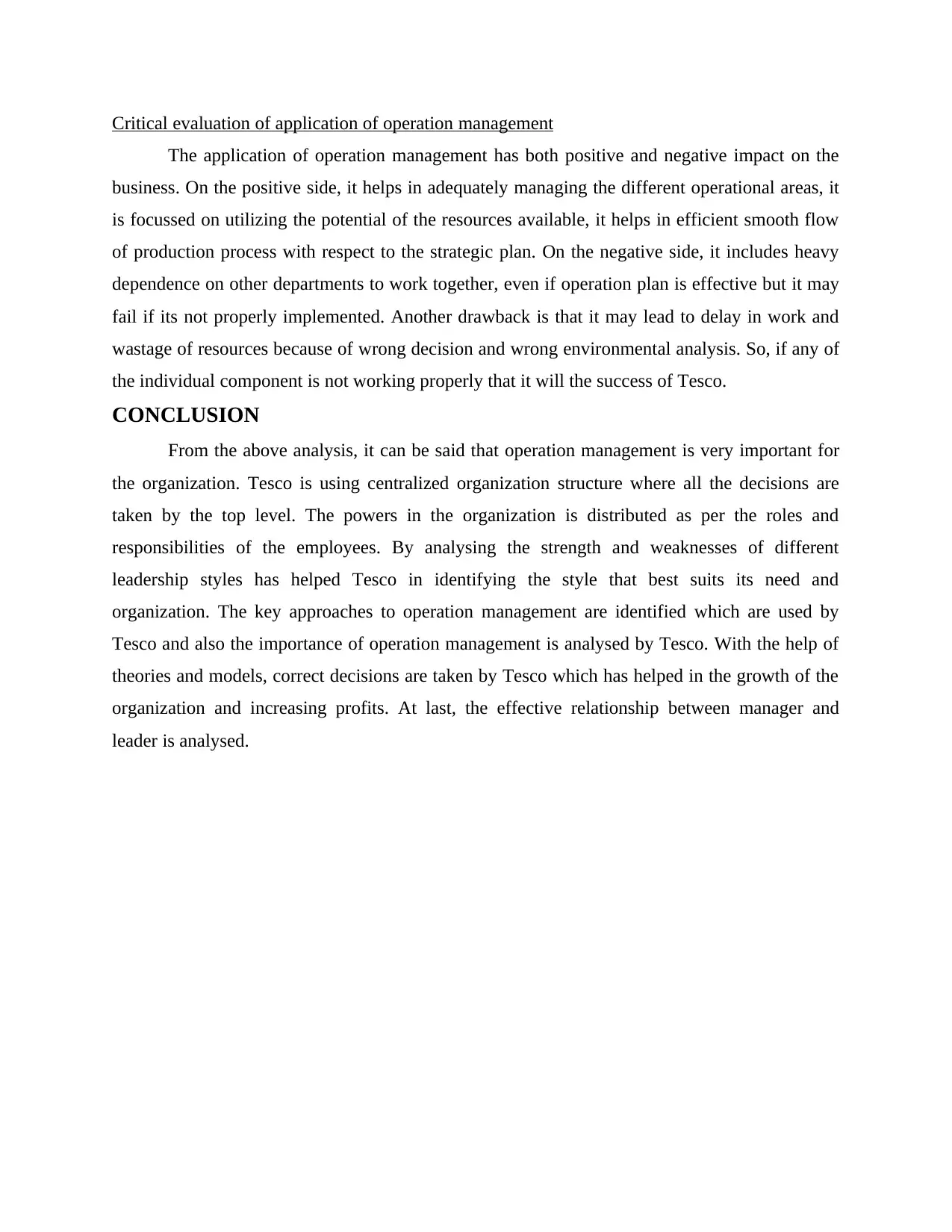
Critical evaluation of application of operation management
The application of operation management has both positive and negative impact on the
business. On the positive side, it helps in adequately managing the different operational areas, it
is focussed on utilizing the potential of the resources available, it helps in efficient smooth flow
of production process with respect to the strategic plan. On the negative side, it includes heavy
dependence on other departments to work together, even if operation plan is effective but it may
fail if its not properly implemented. Another drawback is that it may lead to delay in work and
wastage of resources because of wrong decision and wrong environmental analysis. So, if any of
the individual component is not working properly that it will the success of Tesco.
CONCLUSION
From the above analysis, it can be said that operation management is very important for
the organization. Tesco is using centralized organization structure where all the decisions are
taken by the top level. The powers in the organization is distributed as per the roles and
responsibilities of the employees. By analysing the strength and weaknesses of different
leadership styles has helped Tesco in identifying the style that best suits its need and
organization. The key approaches to operation management are identified which are used by
Tesco and also the importance of operation management is analysed by Tesco. With the help of
theories and models, correct decisions are taken by Tesco which has helped in the growth of the
organization and increasing profits. At last, the effective relationship between manager and
leader is analysed.
The application of operation management has both positive and negative impact on the
business. On the positive side, it helps in adequately managing the different operational areas, it
is focussed on utilizing the potential of the resources available, it helps in efficient smooth flow
of production process with respect to the strategic plan. On the negative side, it includes heavy
dependence on other departments to work together, even if operation plan is effective but it may
fail if its not properly implemented. Another drawback is that it may lead to delay in work and
wastage of resources because of wrong decision and wrong environmental analysis. So, if any of
the individual component is not working properly that it will the success of Tesco.
CONCLUSION
From the above analysis, it can be said that operation management is very important for
the organization. Tesco is using centralized organization structure where all the decisions are
taken by the top level. The powers in the organization is distributed as per the roles and
responsibilities of the employees. By analysing the strength and weaknesses of different
leadership styles has helped Tesco in identifying the style that best suits its need and
organization. The key approaches to operation management are identified which are used by
Tesco and also the importance of operation management is analysed by Tesco. With the help of
theories and models, correct decisions are taken by Tesco which has helped in the growth of the
organization and increasing profits. At last, the effective relationship between manager and
leader is analysed.
⊘ This is a preview!⊘
Do you want full access?
Subscribe today to unlock all pages.

Trusted by 1+ million students worldwide
1 out of 14
Related Documents
Your All-in-One AI-Powered Toolkit for Academic Success.
+13062052269
info@desklib.com
Available 24*7 on WhatsApp / Email
![[object Object]](/_next/static/media/star-bottom.7253800d.svg)
Unlock your academic potential
Copyright © 2020–2025 A2Z Services. All Rights Reserved. Developed and managed by ZUCOL.



